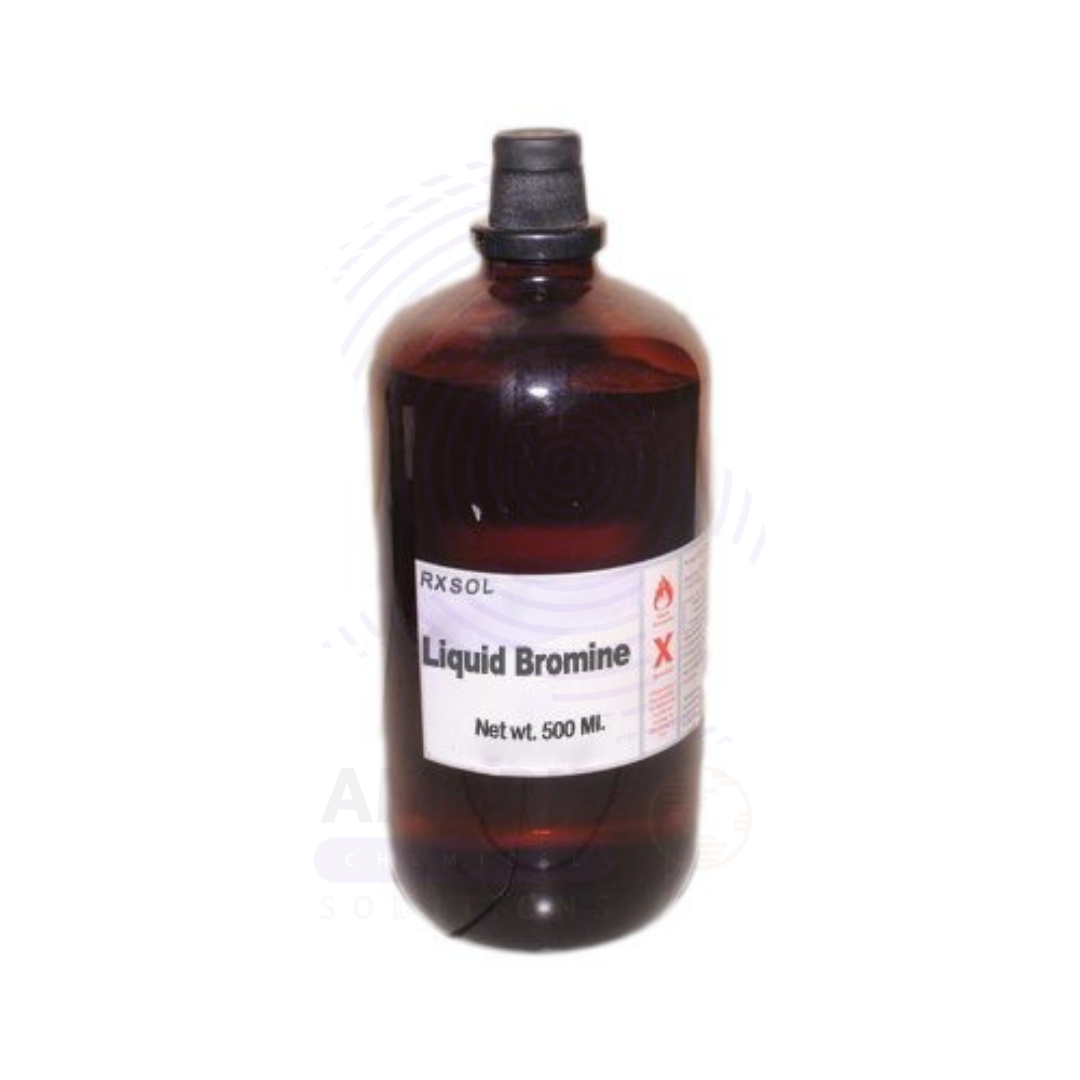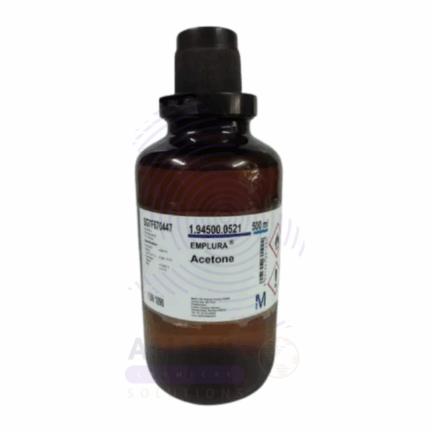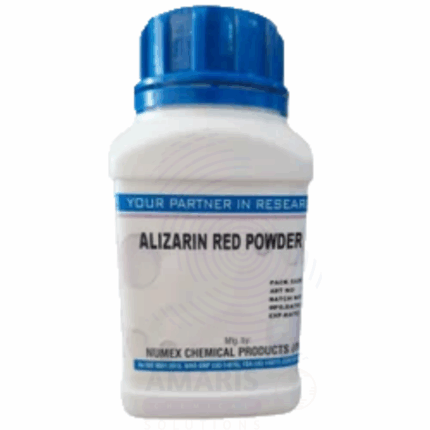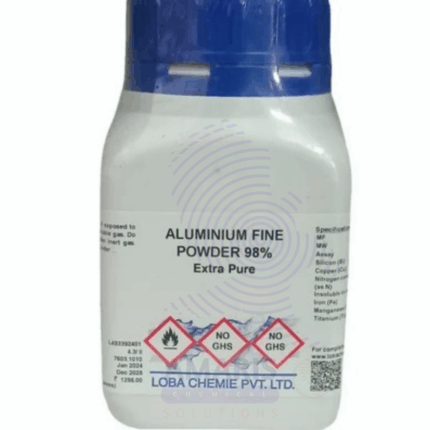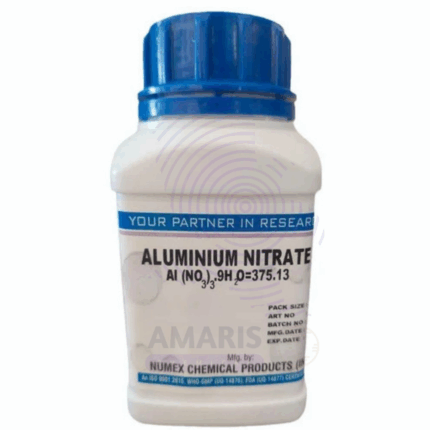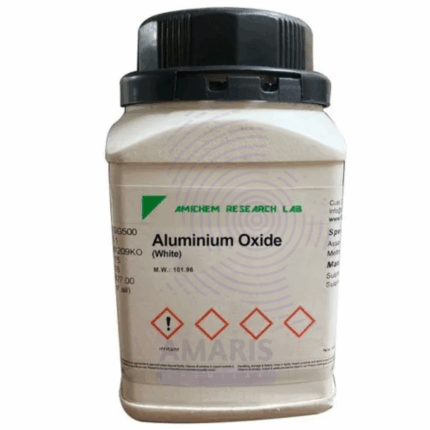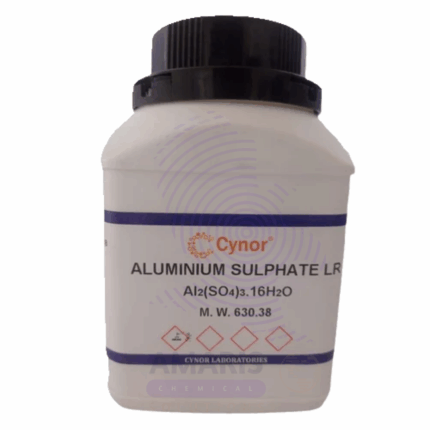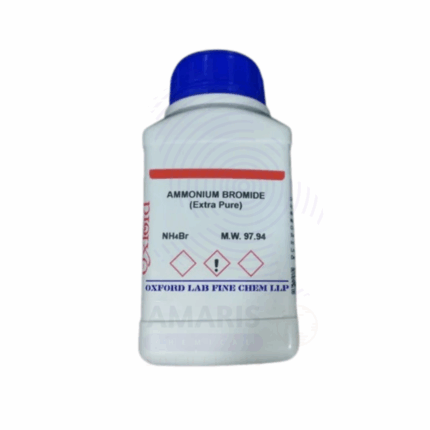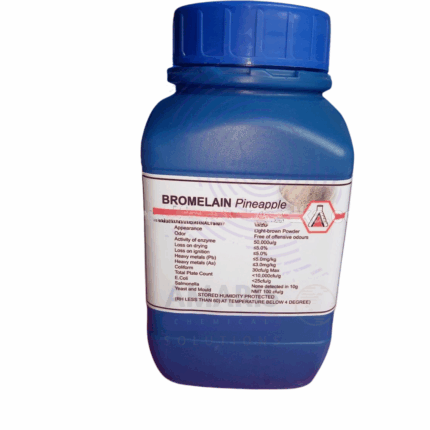
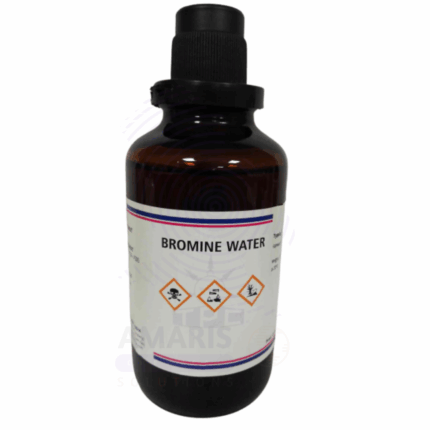
Bromine Liquid Extra Pure
$ 17.00 Original price was: $ 17.00.$ 16.78Current price is: $ 16.78.
Bromine Liquid Extra Pure is a high-purity, reddish-brown volatile liquid used in advanced laboratory research involving halogenation reactions, redox studies, and analytical chemistry. It serves as a powerful oxidizing and brominating agent in organic synthesis, facilitating the substitution of hydrogen atoms with bromine in a wide range of compounds. In inorganic analysis, it is employed in the preparation of bromide salts and in the determination of unsaturation in oils and fats. Due to its high reactivity and corrosiveness, it is handled under strict safety protocols in fume hoods with appropriate protective equipment. The extra pure grade ensures minimal contamination and consistent reactivity, making it suitable for precise and high-sensitivity applications. It must be stored in tightly sealed, corrosion-resistant containers, away from heat, light, and incompatible materials such as organic solvents and reducing agents.
Bromine Liquid Extra Pure
Primary Uses
- Oxidizing Agent in Analytical Chemistry
- Used in redox titrations and chemical assays (e.g., for phenols, sulfides, or unsaturated compounds) due to its strong oxidizing nature.
- Reagent in Organic Synthesis
- Common in labs for electrophilic bromination of alkenes, alkynes, and aromatic compounds, aiding in reaction mechanism studies and synthesis pathways.
- Disinfectant & Microbial Control Testing
- Employed in microbiology labs to assess disinfectant potency, especially in studies of halogen-based antimicrobial agents.
- Preparation of Bromine Water
- Used to prepare bromine water, a reagent for testing alkenes (unsaturation) and phenols through color change reactions.
Secondary Uses
- Spectroscopic Calibration
- Sometimes used in UV-Vis or NMR experiments as a known halogenating agent or to demonstrate signal interference and spectral characteristics.
- Demonstration of Halogen Reactivity
- In teaching labs, shows halogen displacement reactions, trends in reactivity across the halogen group, and redox behavior.
- Precursor for In-Lab Synthesis
- Used to prepare metal bromides, brominated solvents, or organic intermediates for research purposes.
| PACK SIZE |
250 grams Plastic Tin |
|---|
1. Basic Identification Attributes
- Chemical Name: Bromine
- CAS Number: 7726-95-6
- HS Code: 2801.30.00
- Molecular Formula: Br₂
- Molecular Weight: 159.81 g/mol
- Synonyms: Dibromine, Elemental bromine
- Grade: Extra Pure (laboratory/reagent use)
2. Physical & Chemical Properties
- Physical State: Liquid
- Color & Odor: Reddish-brown, pungent suffocating odor
- Boiling Point: 58.8 °C
- Melting Point: −7.2 °C
- Density: 3.12 g/cm³ at 20 °C
- Vapor Pressure: 214 mmHg at 20 °C
- Solubility: Slightly soluble in water; miscible with organic solvents (e.g., carbon tetrachloride, chloroform)
- Corrosivity: Highly corrosive to most materials, including metals and tissues
3. Safety & Hazard Attributes
- GHS Classification:
- Acute Toxicity (Inhalation, Oral, Dermal) – Category 3
- Skin Corrosion – Category 1A
- Eye Damage – Category 1
- Aquatic Acute – Category 1
- GHS Pictograms: ☠️ 🔥 ⚠️ 🌊
- NFPA Ratings:
- Health: 4
- Flammability: 0
- Reactivity: 2
- Inhalation Risks:
- Toxic if inhaled; may cause severe respiratory irritation and lung damage
- Skin/Eye Contact:
- Causes severe burns and permanent eye damage
- Exposure Controls:
- Handle only in a well-ventilated fume hood with full PPE
4. Storage & Handling Attributes
- Storage Conditions:
- Store in tightly sealed, corrosion-resistant containers
- Keep in cool, dry, well-ventilated area away from sunlight
- Incompatible Materials:
- Organic materials, reducing agents, alkalis, metals, ammonia
- Packaging: Sealed glass ampoules or specialized bromine-safe containers
- Special Handling Requirements:
- Use face shield, gloves (butyl rubber or Viton), lab coat
- Handle only under a fume hood due to toxic vapors
5. Regulatory & Compliance Attributes
- Regulatory Status:
- Listed on TSCA, REACH, and other global inventories
- Subject to transport regulations (UN 1744)
- Hazard Symbols: ☠️ ⚠️ 🌊
- Transportation:
- UN Number: 1744
- Hazard Class: 8 (Corrosive), 6.1 (Toxic)
- Packing Group: I (high danger)
- Waste Disposal Method:
- Dispose of via licensed hazardous waste facility
- Do not pour into drains or release into the environment
6. Environmental & Health Impact
- Ecotoxicity:
- Extremely toxic to aquatic life with long-lasting effects
- Persistence:
- Reacts quickly in the environment; does not bioaccumulate
- Carcinogenicity/Mutagenicity:
- Not classified as carcinogenic but causes severe tissue damage
- Health Concerns:
- Systemic toxicity via skin absorption or inhalation
- Burns mucous membranes and respiratory tract
SAFETY PRECAUTIONS
- Personal Protective Equipment (PPE):
- Full-face shield, chemical splash goggles, acid-resistant gloves (e.g., Viton or SilverShield).
- Chemical-resistant lab coat or apron.
- Use a fume hood—never work with bromine in open lab air.
- Handling:
- Extremely corrosive and volatile; handle with extreme caution.
- Avoid all contact with skin, eyes, and respiratory system.
- Open containers slowly and carefully under ventilation.
- Storage:
- Store in tightly sealed amber glass bottles with Teflon-lined caps.
- Keep in a cool, dry, and well-ventilated chemical cabinet.
- Segregate from flammables, organics, ammonia, metals, and alkalis.
- Incompatibilities:
- Violently reactive with organic materials, reducing agents, phosphorus, and many metals.
FIRST AID MEASURES
- Inhalation:
- Move the person to fresh air immediately.
- Administer oxygen if breathing is difficult.
- Seek emergency medical attention—can cause fatal pulmonary edema.
- Skin Contact:
- Immediately flush with large amounts of water (at least 15 min).
- Remove contaminated clothing and call for medical aid.
- Burns may continue to worsen even after exposure ends.
- Eye Contact:
- Rinse eyes thoroughly with water for at least 15 minutes.
- Seek immediate emergency medical attention.
- Ingestion:
- Do not induce vomiting.
- Rinse mouth, give water only if conscious, and seek emergency medical help.
FIRE FIGHTING MEASURES
- Extinguishing Media:
- Bromine is not flammable, but it can accelerate combustion.
- Use dry chemical, CO₂, or foam on nearby materials.
- Hazardous Combustion Products:
- Can release toxic hydrogen bromide (HBr) and bromine vapors in fire.
- Protective Equipment:
- Full-body protective gear and self-contained breathing apparatus (SCBA) are mandatory.


 Preservatives(food)
Preservatives(food) Flavor Enhancers
Flavor Enhancers Acidulants
Acidulants Sweeteners
Sweeteners Antioxidants
Antioxidants Colorants(food)
Colorants(food) Nutraceutical Ingredients (food)
Nutraceutical Ingredients (food) Nutrient Supplements
Nutrient Supplements Emulsifiers
Emulsifiers
 Collectors
Collectors Dust Suppressants
Dust Suppressants Explosives and Blasting Agents
Explosives and Blasting Agents Flocculants and Coagulants
Flocculants and Coagulants Frothers
Frothers Leaching Agents
Leaching Agents pH Modifiers
pH Modifiers Precious Metal Extraction Agents
Precious Metal Extraction Agents
 Antioxidants(plastic)
Antioxidants(plastic) Colorants (Pigments, Dyes)
Colorants (Pigments, Dyes) Fillers and Reinforcements
Fillers and Reinforcements Flame Retardants
Flame Retardants Monomers
Monomers Plasticizers
Plasticizers Polymerization Initiators
Polymerization Initiators Stabilizers (UV, Heat)
Stabilizers (UV, Heat)
 Antifoaming Agents
Antifoaming Agents Chelating Agents
Chelating Agents Coagulants and Flocculants
Coagulants and Flocculants Corrosion Inhibitors
Corrosion Inhibitors Disinfectants and Biocides
Disinfectants and Biocides Oxidizing Agents
Oxidizing Agents pH Adjusters
pH Adjusters Scale Inhibitors( water)
Scale Inhibitors( water)
 Antioxidants(cosmetic)
Antioxidants(cosmetic) Emollients
Emollients Fragrances and Essential Oils
Fragrances and Essential Oils Humectants
Humectants Preservatives
Preservatives Surfactants(cosmetic)
Surfactants(cosmetic) Thickeners
Thickeners UV Filters
UV Filters
 Fertilizers
Fertilizers Soil Conditioners
Soil Conditioners Plant Growth Regulators
Plant Growth Regulators Animal Feed Additives
Animal Feed Additives Biostimulants
Biostimulants Pesticides (Herbicides, Insecticides, Fungicides)
Pesticides (Herbicides, Insecticides, Fungicides)
 Active Pharmaceutical Ingredients (APIs)
Active Pharmaceutical Ingredients (APIs) Excipients
Excipients Solvents(pharmaceutical)
Solvents(pharmaceutical) Antibiotics
Antibiotics Antiseptics and Disinfectants
Antiseptics and Disinfectants Vaccine Adjuvants
Vaccine Adjuvants Nutraceutical Ingredients (pharmaceutical)
Nutraceutical Ingredients (pharmaceutical) Analgesics & Antipyretics
Analgesics & Antipyretics
 Analytical Reagents
Analytical Reagents Solvents(lab)
Solvents(lab) Chromatography Chemicals
Chromatography Chemicals Spectroscopy Reagents
Spectroscopy Reagents microbiology-and-cell-culture-reagents
microbiology-and-cell-culture-reagents Molecular Biology Reagents
Molecular Biology Reagents Biochemical Reagents
Biochemical Reagents Inorganic and Organic Standards
Inorganic and Organic Standards Laboratory Safety Chemicals
Laboratory Safety Chemicals Specialty Laboratory Chemicals(Special Laboratory Equipment)
Specialty Laboratory Chemicals(Special Laboratory Equipment)
 Demulsifiers
Demulsifiers Hydraulic Fracturing Fluids
Hydraulic Fracturing Fluids Scale Inhibitors(oil)
Scale Inhibitors(oil) Surfactants(oil)
Surfactants(oil) Drilling Fluids
Drilling Fluids
 Dyes and Pigments
Dyes and Pigments Bleaching Agents
Bleaching Agents Softening Agents
Softening Agents Finishing Agents
Finishing Agents Antistatic Agents
Antistatic Agents
 Admixtures
Admixtures Waterproofing Agents
Waterproofing Agents Sealants and Adhesives
Sealants and Adhesives Curing Compounds
Curing Compounds Concrete Repair Chemicals
Concrete Repair Chemicals Anti-Corrosion Coatings
Anti-Corrosion Coatings
 Surfactants(cleaning)
Surfactants(cleaning) Builders
Builders Enzymes
Enzymes Solvents (Cleaning)
Solvents (Cleaning) Fragrances
Fragrances
 Electronic Chemicals
Electronic Chemicals Catalysts
Catalysts Lubricants
Lubricants Photographic Chemicals
Photographic Chemicals Refrigerants
Refrigerants Automotive chemicals
Automotive chemicals Pyrotechnic Chemicals
Pyrotechnic Chemicals
 Biodegradable Surfactants
Biodegradable Surfactants Bio-based Solvents
Bio-based Solvents Renewable Polymers
Renewable Polymers Carbon Capture Chemicals
Carbon Capture Chemicals Wastewater Treatment Chemicals
Wastewater Treatment Chemicals
 Pigments
Pigments Solvents(paint)
Solvents(paint) Specialty Coatings
Specialty Coatings Binders/Resins
Binders/Resins Additives
Additives Driers
Driers Anti-Corrosion Agents
Anti-Corrosion Agents Functional Coatings
Functional Coatings Application-Specific Coatings
Application-Specific Coatings
 Fresh Herbs
Fresh Herbs Ground Spices
Ground Spices Whole Spices
Whole Spices Spice Blends
Spice Blends Dried Herbs
Dried Herbs
 Leavening Agents
Leavening Agents Dough Conditioners
Dough Conditioners Flour Treatments
Flour Treatments Fat Replacers
Fat Replacers Decoratives
Decoratives Preservatives(baking)
Preservatives(baking)
 Plasticizers & Softeners
Plasticizers & Softeners Reinforcing Agents
Reinforcing Agents Adhesion Promoters
Adhesion Promoters Vulcanizing Agents
Vulcanizing Agents Antidegradants
Antidegradants Blowing Agents
Blowing Agents Fillers & Extenders
Fillers & Extenders Accelerators & Retarders
Accelerators & Retarders